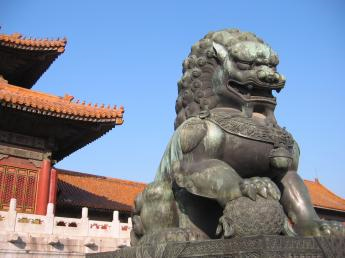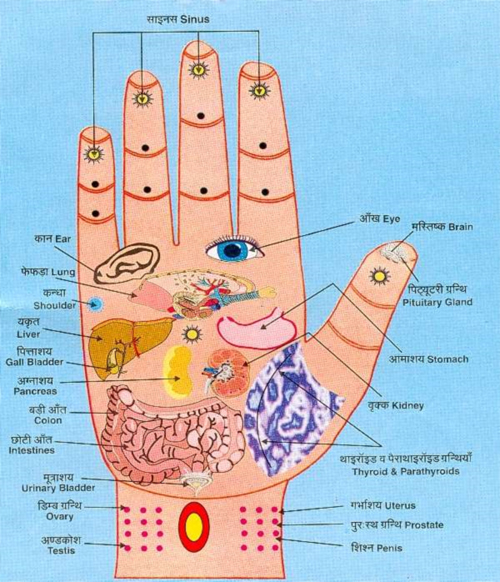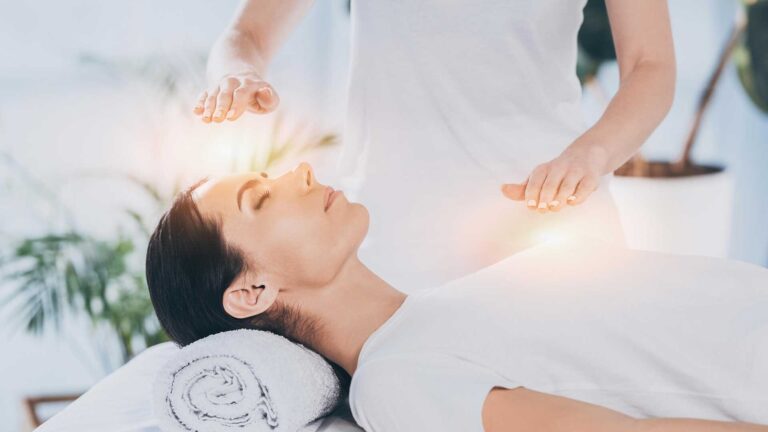Acupressure
Acupressure is an ancient healing art that uses the fingers to press key points on the surface of the skin to stimulate the body’s natural self-curative abilities. When these points are pressed, they release muscular tension and promote the circulation of blood and the body’s life force to aid healing. Acupuncture and acupressure use the same points, but acupuncture employs needles, while acupressure uses the gentle but firm pressure of hands (and even feet). There is a massive amount of scientific data that demonstrates why and how acupuncture is effective. But acupressure, the older of the two traditions, was neglected after the Chinese developed more technological methods for stimulating points with needles and electricity. Acupressure, however, continues to be the most effective method for self-treatment of tension-related ailments by using the power and sensitivity of the human hand.
Foremost among the advantages of acupressure’s healing touch is that it is safe to do on yourself and others – even if you’ve never done it before – so long as you follow the instructions and pay attention to the cautions. There are no side effects from drugs, because there are no drugs. And the only equipment needed are your own two hands. You can practice acupressure therapy any time, anywhere.
Acupressure can be effective in helping relieve headaches, eyestrain, sinus problems, neck pain, backaches, arthritis, muscle aches, and tension due to stress. You can also use self-acupressure to relieve anxiety and to help you get to sleep at night.


There are also great advantages to using acupressure as a way to balance the body and maintain good health. The healing touch of acupressure reduces tension, increases circulation, and enables the body to relax deeply. By relieving stress, acupressure strengthens resistance to disease and promotes wellness.
In acupressure, local symptoms are considered an expression of the condition of the body as a whole. A tension headache, for instance, may be rooted in the shoulder and neck area. Thus acupressure focuses on relieving pain and discomfort as well as on responding to tension before it develops into a “dis-ease” that is, before the constrictions and imbalances can do further damage. By using a combination of self-help methods such as trigger point stimulation, deep breathing, range-of-motion exercises, and relaxation techniques, you can improve your condition as well as feel more alive, healthy and in harmony with your life.
The Development of Acupressure
The origins of acupressure are as ancient as the instinctive impulse to hold your forehead or temples when you have a headache. Everyone at one time or another has used his or her hands spontaneously to hold tense or painful places on the body.
More than 5,000 years ago, the Chinese discovered that pressing certain points on the body relieved pain where it occurred and also benefited other parts of the body more remote from the pain and the pressure point. Gradually, they found other locations that not only alleviated pain but also influenced the functioning of certain internal organs.
In the early Chinese dynasties, when stones and arrows were the only implements of war, many soldiers wounded on the battlefield reported that symptoms of disease that had plagued them for years had suddenly vanished. Naturally, such strange occurrences baffled the physicians who could find no logical relationship between the trauma and the ensuing recovery of health. After years of meticulous observation, ancient Chinese physicians developed ways of curing certain illnesses by striking or piercing specific points on the surface of the body.


As with the Chinese soldiers, people through the ages have found the most effective ways to help themselves by trial and error. The art and science of acupressure was practiced by the contributions of people whose awareness was so highly developed that they could feel where the bodies of people in pain were constricted and sense which trigger points would alleviate the problem. The Chinese have practiced self-acupressure for over 5,000 years as a way of keeping themselves well and happy.
Many of the health problems in our society – from bad backs to arthritis – are the result of living unnaturally. Stress, tension, lack of exercise, poor eating habits, and poor posture contribute to the epidemic of degenerative diseases in our culture. Acupressure is one way to help your body fight back and balance itself in the face of the pressures of modern life.
How Acupressure Works
Acupressure points (also called potent points) are places on the skin that are especially sensitive to bioelectrical impulses in the body and conduct those impulses readily.
Traditionally, Asian cultures conceived of the points as junctures of special pathways that carried the human energy that the Chinese call chi and the Japanese call ki . Western scientists have also mapped out and proven the existence of this system of body points by using sensitive electrical devices.
Stimulating these points with pressure, needles, or heat triggers the release of endorphins , which are the neurochemicals that relieve pain. As a result, pain is blocked and the flow of blood and oxygen to the affected area is increased. This causes the muscles to relax and promotes healing.
Because acupressure inhibits the pain signals sent to the brain through a mild, fairly painless stimulation, it has been described as closing the “gates” of the pain-signaling system, preventing painful sensations from passing through the spinal cord to the brain.
Besides relieving pain, acupressure can help rebalance the body by dissolving tensions and stresses that keep it from functioning smoothly and that inhibit the immune system. Acupressure enables the body to adapt to environmental changes and resist illness.
Tension tends to concentrate around acupressure points. When a muscle is chronically tense or in spasm, the muscle fibers contract due to the secretion of lactic acid caused by fatigue, trauma, stress, chemical imbalances, or poor circulation. For instance, when you are under a great deal of stress you may find you have difficulty breathing. Certain acupressure points relieve chest tension and enable you to breathe deeply.
As a point is pressed, the muscle tension yields to the finger pressure, enabling the fibers to elongate and relax, blood to flow freely, and toxins to be released and eliminated. Increased circulation also brings more oxygen and other nutrients to affected areas. This increases the body’s resistance to illness and promotes a longer, healthier, more vital life. When the blood and bioelectrical energy circulate properly, we have a greater sense of harmony, health, and well-being.
Ways to Use Acupressure
Acupressure’s potent points can be used to enhance many aspects of life. In addition to managing stress, you can use acupressure to relieve and prevent sports injuries. Sports massage has been widely used by athletes before and after Olympic events. Acupressure complements sports medicine treatments by using points and massage techniques to improve muscle tone and circulation and relieve neuromuscular problems.
The Chinese have also used acupressure as a beauty treatment for thousands of years. You can use potent points to improve skin condition and tone and relax the facial muscles, which can lessen the appearance of wrinkles without drugs.
Although acupressure is not a substitute for medical care, it is often an appropriate complementary treatment. It can, for instance, speed the healing of a broken bone once it has been set, or aid a cancer patient by helping to alleviate some of the associated pain and anxiety of the disease.
Similarly, acupressure can be an effective adjunct to chiropractic treatment. By relaxing and toning the back muscles, acupressure makes the spinal adjustments easier and more effective, and the results last longer. In fact, the two therapies were originally practiced together in ancient China .
Psychotherapy patients can derive benefits from acupressure by using it to heighten body awareness and deal with stress. When powerful emotions are free and unresolved, the body stores the resulting tension in the muscles. Acupressure can help restore emotional balance by releasing the accumulated tension caused by repressed feelings.
An acupressure point actually has two identities and ways of working. When you stimulate a point in the same area where you feel pain or tension, it’s called a local point. That same point can also relieve pain in a part of the body that is distant from the point, in which case it is called a trigger point. This triggering mechanism works through a human electrical channel called a meridian . The meridians are pathways that connect the acupressure points to each other as well as to the internal organs. Just as blood vessels carry the blood that nourishes the body physically, the meridians are distinct channels that circulate electrical energy throughout the body. They are thought to be part of a master communications system of universal life energy, connecting the organs with all sensory, physiological, and emotional aspects of the body. This physical network of energy also contains key points that we can use to deepen our spiritual awareness as we heal ourselves,
Because the stimulation of one point can send a healing message to other parts of the body, each acupressure point can benefit a variety of complaints and symptoms. The highly effective acupressure point in the webbing between your thumb and index finger, for instance, is not only beneficial for relieving arthritic pain in the hand, but also benefits the colon and relieves problems in the facial area and the head, including headaches, toothaches, and sinus problems.
Tonic points improve your condition and maintain general health. They strengthen the overall body system and fortify various internal organs and vital systems of the body.
How to Find a Point: Acupressure Point Names and Reference Numbers
You locate an acupressure point by referring to anatomical landmarks. To help you find them, all of the points in this book are illustrated with a description of these landmarks (such as bone indentations and protrusions).
Some acupressure points lie underneath major muscle groups. While points near a bone structure usually lie in an indentation, muscular points lie within a muscular cord, band, or knot of tension. To stimulate the point, press directly on the cord or into the hollow.
As acupressure evolved, each of the 365 points was named poetically, originally with a Chinese character. The imagery of its name offers insight into either a point’s benefits or location. For instance, the name Hidden Clarity refers to the mental benefit of the point: It clears the mind. Shoulder’s Corner refers to that point’s location. The Three Mile Point earned its name because it gives a person an extra three miles of energy. Runners and hikers have used this famous point to increase stamina and endurance.
Some of the names of the acupressure points also serve as a powerful meditation tool. By pressing a point and silently repeating its name while you visualize its benefit and breathe deeply, you can realize the full potential power that each point offers. As you hold the Sea of Vitality points in your lower back, breathe deeply and visualize each breath replenishing your deep reservoir of vitality. Use the power of your mind to strengthen and help heal your lower back.
You can create affirmations with the names of the points — powerful action statements that amplify a point’s benefits. For example, hold the Letting Go points on the upper, outer chest with your fingertips. Breathe deeply. Imagine yourself letting go of tension, frustration, and stress. As you hold and breathe into these points, repeat to yourself that you are now letting go of all negativity and irritability.
In addition to its name, each point was assigned an identification number to track its placement along the body. Point location numbers, such as St 3 or GI3 21, are a standard referencing system used by professional acupressurists and acupuncturists and so I use them as an additional label, too.
The Third Eye: A Potent Spiritual Point
Using the healing touch of acupressure can also be a practical way of deepening your spiritual life. By lightly touching the Third Eye Point, for instance, just above the bridge of the nose, for a couple of minutes, you can enhance your inner awareness. If you want to progress further, meditate on this point for five to ten minutes each day, and within a few weeks, you may notice that your intuition will begin to increase. Concentrating on the Third Eye Point can nourish your spiritual nature.
Spirituality is not disembodied; the most powerful spiritual experiences are rooted in one’s body. When I close my eyes and lightly touch the Third Eye Point, and completely focus my attention on that spot between my eyebrows, I heighten my sense of myself. I become intensely aware of how my body feels, how my breathing feels. As I sense the blood pulsing throughout my body, I experience the flow of life energy. And if I continue breathing deeply, sitting with my spine straight, I become aware of every part of my body at once – as a harmonious, unified presence. When I meditate, this often leads to a powerful sense of oneness with the world. Acupressure’s potent power can heal us both physically and spiritually.
The healing benefits of acupressure involve both the relaxation of the body and its positive effects on the mind. As tension is released, you not only feel good physically, but you also feel better emotionally and mentally. When your body relaxes, your mind relaxes as well, creating another state of consciousness. This expanded awareness leads to mental clarity and a healthier physical and emotional healing, dissolving the division between the mind and body.
Ilza Veith, trans., The Yellow Emperor’s Classic of Internal Medicine (Berkeley: University of California Press, 1949). An ancient Chinese medical text. Ilza Veith, trans., The Yellow Emperor’s Classic of Internal Medicine (Berkeley: University of California Press, 1949). An ancient Chinese medical text.
Resources:
Dr. Stephen Thomas Chang, The Complete Book of Acupuncture (Berkeley: Celestial Arts, 1976), 14. Dr. Stephen Thomas Chang, The Complete Book of Acupuncture (Berkeley: Celestial Arts, 1976), 14.
T. Tan Leng, Margaret Y. C. Tan, and Ilza Veith, Acupuncture Therapy – Current Chinese Practice (Philadelphia: Temple University, 1973). T. Tan Leng, Margaret Y. C. Tan, and Ilza Veith, Acupuncture Therapy – Current Chinese Practice (Philadelphia: Temple University, 1973).
For additional information on tonic points, see Michael Reed Gach, Greater Energy at Your Fingertips (Berkeley: Celestial Arts, 1986), 9-25.
(Text Copyright, Michael Reed Gach & Bantam Books, 1990)

